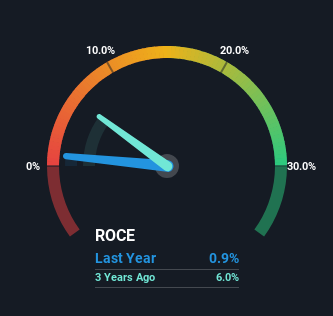There Are Reasons To Feel Uneasy About Maple Leaf Foods' (TSE:MFI) Returns On Capital
If you're looking for a multi-bagger, there's a few things to keep an eye out for. Ideally, a business will show two trends; firstly a growing return on capital employed (ROCE) and secondly, an increasing amount of capital employed. Put simply, these types of businesses are compounding machines, meaning they are continually reinvesting their earnings at ever-higher rates of return. Although, when we looked at Maple Leaf Foods (TSE:MFI), it didn't seem to tick all of these boxes.
Return On Capital Employed (ROCE): What Is It?
Just to clarify if you're unsure, ROCE is a metric for evaluating how much pre-tax income (in percentage terms) a company earns on the capital invested in its business. Analysts use this formula to calculate it for Maple Leaf Foods:
Return on Capital Employed = Earnings Before Interest and Tax (EBIT) ÷ (Total Assets - Current Liabilities)
0.0094 = CA$33m ÷ (CA$4.6b - CA$1.0b) (Based on the trailing twelve months to December 2023).
Therefore, Maple Leaf Foods has an ROCE of 0.9%. Ultimately, that's a low return and it under-performs the Food industry average of 8.7%.
See our latest analysis for Maple Leaf Foods
Above you can see how the current ROCE for Maple Leaf Foods compares to its prior returns on capital, but there's only so much you can tell from the past. If you're interested, you can view the analysts predictions in our free analyst report for Maple Leaf Foods .
So How Is Maple Leaf Foods' ROCE Trending?
In terms of Maple Leaf Foods' historical ROCE movements, the trend isn't fantastic. Over the last five years, returns on capital have decreased to 0.9% from 7.9% five years ago. Meanwhile, the business is utilizing more capital but this hasn't moved the needle much in terms of sales in the past 12 months, so this could reflect longer term investments. It may take some time before the company starts to see any change in earnings from these investments.
The Bottom Line On Maple Leaf Foods' ROCE
To conclude, we've found that Maple Leaf Foods is reinvesting in the business, but returns have been falling. Additionally, the stock's total return to shareholders over the last five years has been flat, which isn't too surprising. Therefore based on the analysis done in this article, we don't think Maple Leaf Foods has the makings of a multi-bagger.
On a separate note, we've found 3 warning signs for Maple Leaf Foods you'll probably want to know about.
While Maple Leaf Foods may not currently earn the highest returns, we've compiled a list of companies that currently earn more than 25% return on equity. Check out this free list here.
Have feedback on this article? Concerned about the content? Get in touch with us directly. Alternatively, email editorial-team (at) simplywallst.com.
This article by Simply Wall St is general in nature. We provide commentary based on historical data and analyst forecasts only using an unbiased methodology and our articles are not intended to be financial advice. It does not constitute a recommendation to buy or sell any stock, and does not take account of your objectives, or your financial situation. We aim to bring you long-term focused analysis driven by fundamental data. Note that our analysis may not factor in the latest price-sensitive company announcements or qualitative material. Simply Wall St has no position in any stocks mentioned.

